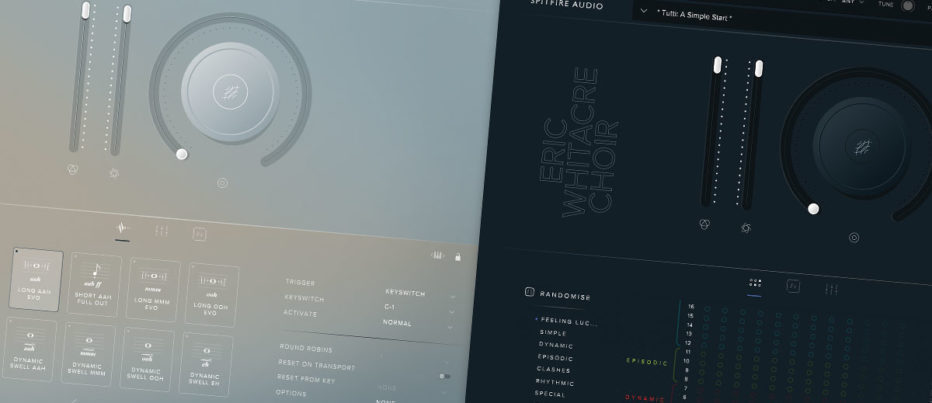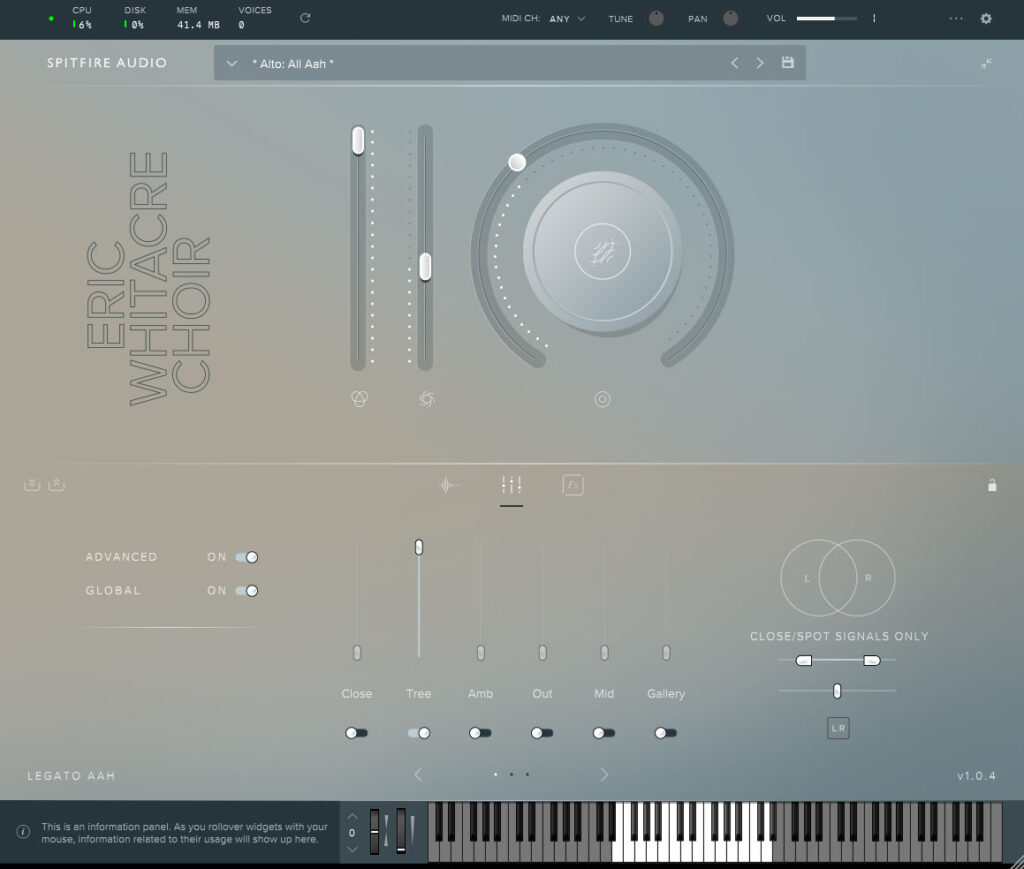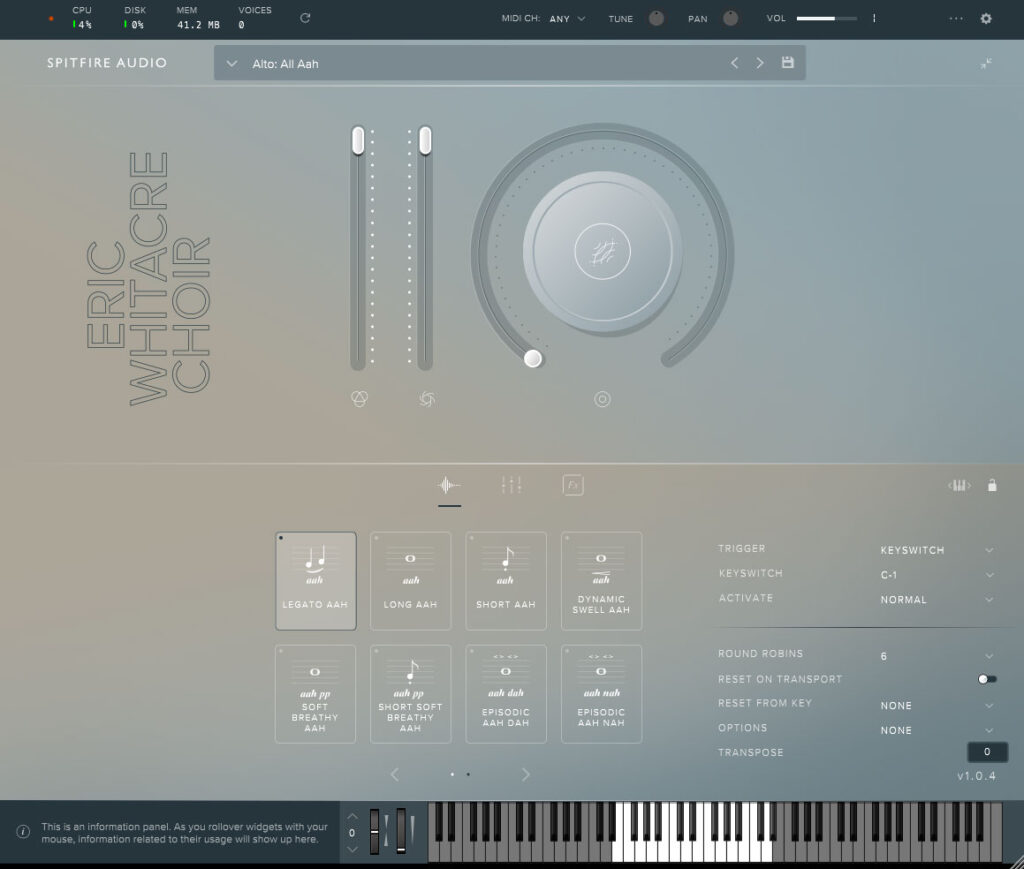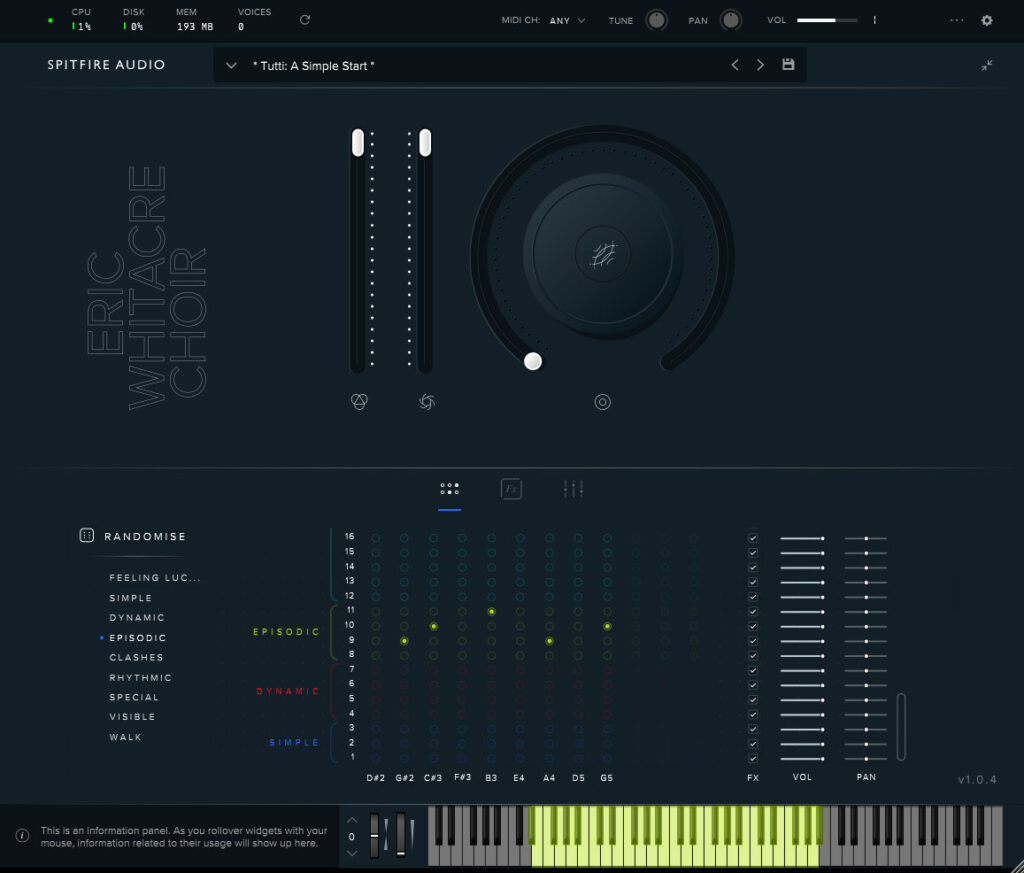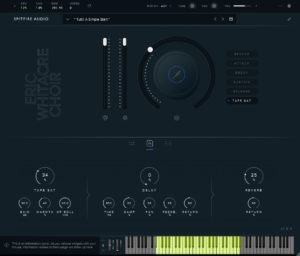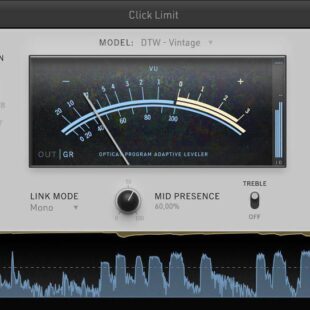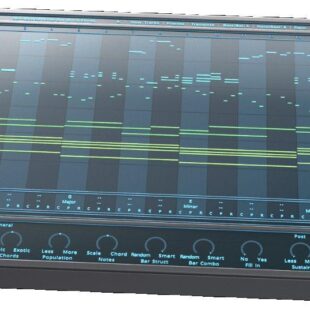SPITFIRE AUDIO: ERIC WHITACRE CHOIR – CHORALE BELLISSIMO
Hi everyone and welcome to this week’s in-depth review – Spitfire Audio’s brand new (in many ways) sample library Eric Whitacre Choir. The library’s namesake is one of the authorities in traditional choral arrangement and composition so, combining this with Spitfire Audio’s cutting-edge technical innovations, looks to be the perfect amalgamation of talents.
Having seen a lot of chatter on the Internet about the release of this new title from Spitfire, I am eager to hear how they have adapted their well-honed orchestral-focused recording skills to this new medium, and more importantly how the chorale library will coincide with other products in the range. So I am very excited to get into this review.
Overview
Eric Whitacre Choir is a VSTi-compatible chorale vocal library featuring 22 Singers (six sopranos, five altos, five tenors and six basses) recorded at the Lyndhurst Hall in Air Studios, London.
Designed primarily to support orchestral arrangements, the library features Tutti ensembles, sectional group splits and the EVO Grid randomiser system. The group of male and female singers was selected from Eric Whitacre’s main choir and features a full range of multi-layered oohs ahhs and mmm’s, plus an extended selection of more unusual decorative vocal tricks and effects.
The library features two instrument patches; the light grey core library, and the dark green EVO Grid.
The core version contains all sample banks separated into playable categories; tutti (full ensemble), soprano, alto, tenor, and basses, with a starring system available for recording favourites.
The EVO Grid is a unique rework of the interface which allows you to plot articulations on an X/Y style grid system, resulting in interesting combinations when played across your keyboard. The idea is to somewhat randomly mix and match articulations from various styles to create unique and constantly evolving textures.
Both versions have exhaustive collections of articulations to choose from. Typical longs, Aahs, Mmms and Oohs are all here as mentioned, with many specific vocal FX, swells, non-vibratos, crescendos, harmonics, chord inversions and microtonal pitch variants to choose from. Each articulation comes with a handy information icon to explain its application.
A large selection of microphones is included with typical close, Decca tree, ambient and outriggers, and some interesting gallery, spot mics focusing on specific sections of the group, and finally, some fun group presets simply labelled small, medium and big. These are quite handy starting points to get you going.
The hefty library weighs in at slightly over 150 GB, though Spitfire Audio offers a purpose-built hard drive service I would urge you to consider, with the delivery of your library on a custom drive within a few days. At UKP 60 extra this represents quite good value if you need to upgrade anyway.
Eric Whitacre
Nevadan native Eric Whitacre is a Grammy-awarded composer and Chorale Master at the Walt Disney Concert Hall with a long list of credits, including Hans Zimmer, Julian Lloyd Webber, and the London Symphony Orchestra; composer of the electronica musical Paradise Lost: Shadows and Wings which may be familiar to readers, or perhaps his collaboration with Imogen Heap, Annie Lennox and soul singer Laura Mvula.
The Eric Whitacre Singers are an acclaimed ensemble comprising some of the leading vocal talents available. Performing worldwide the group received a Grammy award for Best Choral Performance for their album Light And Gold.
The Sound
I purposely avoided watching any of the demo videos online as I did not want to spoil the initial impact of hearing this library in my own studio, and wow – I am so glad I did.
This is one of those rare moments when you play a single chord and just know you have a great library in your hands. The human voice is such a powerful instrument, and when captured as well as this, it is difficult to describe one’s emotions without using superlatives.
Playing through each of the core and EVO Grid patches it is immediately clear a lot of effort has been spent detailing the finer nuances of the project. Spitfire Audio’s mastery of capturing the ambient beauty in the environment, allowing for even the quietest of notes to gently evolve and be heard clearly is stunning.
I have always admired their focus on the balance between space and sound, and this library putting all of those technical skills perfected into use.
The chorale as a whole is capable of becoming quite vociferous if pushed with some heavy-handed chords, but the beauty is in the subtle dynamic range and the wonderful legato scripting allowing a convincing and immersive performance from your keyboard.
The core patch presents a full-bodied Tutti ensemble preset which is surely the showcase for the library, but stepping through each of the sub-patches reveals more detail in each of the individual sections than expected, something that is somewhat masked when played in full ensemble mode.
The male basses are very distinctive, not just for the bass frequencies, but the characteristic deep, almost guttural presence in the voices. The sound is very open and brings in feelings of Gregorian chanting on longer sustain chords, especially in the EVO Grid. Very low register Mmms lose power, as expected, but there is still a solid underlining foundation here for building on.
The tenors are the strongest of the male section with a powerful mid-range presence across the range. I am impressed with the assorted articulation presets, all showing plenty of variation with mostly predictable mod wheel control for dynamics making this section very playable from the keyboard.
The mixed alto group again has strong, consistent dynamics across the range, particularly the Mmms. Some pins in the EVO Grid can get a little unwieldy when incorrectly paired with subtle basses or sopranos, so care needs to be given to the dynamics.
The soprano group is fantastic, notably in the upper register when pushed up into the mezzo range. The legato is beautifully controllable with a wonderfully ethereal quality, very enjoyable to play over a foundational base from the other sections.
Across all groups, the pitch is impeccable (and, yes I did test this). There is some deviation in timing when mixing articulation styles, as to be expected.
There is something magical in the way Lyndhurst Hall enhances a vocal ensemble. Something about the way voice reverberates or interacts with the acoustics. There is a warmth and body to the sound that never overwhelms the source, but compliments and sweetens the voice in an organic way digital processing can’t match.
The sound of the human voice merges beautifully with strings, particularly Spitfire’s own Symphonic, Chamber and Studio string libraries. Though there are plenty of opportunities to blast out rather apocalyptic choral sounds, the group has more than enough range to sound equally impressive at the low-velocity range.
The combination of the EVO Grid patches from the Eric Whitecare Choir and Olafur Arnalds Evolutions is a superb match. I spent many hours just experimenting with sound ideas, with every combination providing no shortage of ideas.
Getting a little adventurous with Spitfire’s eDNA Earth and BT Phobos changed the mood but provided no less creative inspiration. The human voice magically elevates almost anything it is combined with.
In The Studio
Spitfire Audios’ new flagship interface was first seen with the Hans Zimmer Strings library late last year – to some degree of success – and more recently with the excellent “Labs” titles. The new layout EVO Grid system reworks the workflow from the rather tired old Kontakt GUI, but not enough to upset your muscle memory.
The ostentatious GUI is undoubtedly styling over functionality, but I love that kind of thing when it’s done well. Even though nearly a quarter of the UI is dedicated to the logo and another quarter to the most ridiculously large control knob, it feels luxurious and professional. We all need better design in our lives.
The large selection of microphones I feel is more applicable to voice than to previous orchestral libraries using this new interface layout. The provided choices seem better suited, or at least, better implemented towards the source than before. I found each microphone set provided excellent characteristics as either part of a larger mix or just used by itself. I particularly like the wonderful Decca tree sound, though I’m often torn between this and choosing a blend of spot and gallery mics.
Ultimately, no matter which setting you decide on, there is plenty of scope for audiophiles to hone precisely the sound they are looking for, mostly without requiring external 3rd party processing (unless you’re wanting something more extreme).
The built-in effects are not particularly aggressive but enough to affect the voice without getting too crazy. The weird combination of tape saturation and delay seems a bit out of place in the EVO Grid, though I imagine sound designers will love the creative possibilities here.
I’m not convinced the microphone mixer layout is optimal. Having to scroll through pages of settings when such a vast amount of screen real estate is dedicated to negative space and the logo makes me wonder if a better system can be implemented without losing the styling.
EVO-lutions
The EVO Grid system benefits most from the new treatment. The clunky Kontakt interface has been replaced with this more intuitive layout. The grid flows downwards now with pins horizontal, a randomised generator to the left and level and pan controls to the right.
Evo’s are all about irregularity, a point made clear with the large randomise dice section on the GUI. I love creating my own pins in the wonderful-sounding episodic and pitch-clashing articulations, though leaving fate to the roll of a dice is rewarding more often than not.
Even a complete newbie to the EVO Grid will have no trouble understanding what’s going on here within a few minutes of experimenting. Using the random presets sets up some nice variations to showcase the basic operation, and from there swapping and changing pins around manually becomes fairly intuitive.
I have always been a big fan of the EVO Grid system, especially because the randomness of the results never feels too wacky, yet there are always new and interesting combinations.
The included delay and tape saturation effects are a little curious for me. I am not sure about the application for ping-ponging vocals with distortion applied, but I guess some people may like that kind of thing.
I found the default ADSR a tad too aggressive for my taste, but reducing the attack and release a little blurs chords more when performing if you are finding things too choppy sounding.
Conclusion
Spitfire Audio has knocked this one right out of the ballpark on many levels. Audibly, no doubt. Aesthetically; the interface is fresh while inspiring, and performance is optimised with a simple and straightforward workflow.
Eric Whitacre Choir beautifully ties together Spitfire Audio’s other libraries. The natural voice creates an ability somehow to anchor and transform a somewhat impersonal orchestra into something more humanistic. This really is magic fairy dust for immersing the listener and binding your arrangments in a very organic way.
Both instrument variations included are excellent, but for me, the EVO Grid is an absolute triumph. I believe this is the best implementation of the system to date, and though not as extreme in use as seen in other libraries, the subtle randomness is perfectly suited to the spirit of the choir.
If there are Negatives, perhaps it is a little on the pricey side, but the 150GB library feels like a lot of content for your investment. The hit to your credit card will be forgotten the moment you begin to play.
I am so pleased Spitfire has started venturing down this path and I can’t wait to see future developments with choral groups. Without a doubt, this is one of the best sample libraries of its type available and I suggest it should be required buying for connoisseurs and composers alike.
For full details and purchasing options visit the Spitfire Audio website www.spitfireaudio.com

Like the review? Shout us a cup of coffee!

